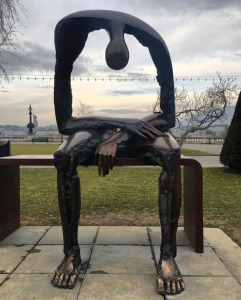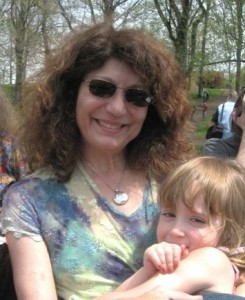March 26, 2019 by Laurel Krause
 As a survivor of the May 4, 1970 Kent State massacre, late March 2019 has been a painful time. Over the past week two survivors of the Parkland massacre have killed themselves and one father of a child killed at Sandy Hook took his life at Town Hall. These three suicides provide signposts for the world yet few in America understand the reasons these survivors have taken their lives. https://cnn.it/2CPhEB1
As a survivor of the May 4, 1970 Kent State massacre, late March 2019 has been a painful time. Over the past week two survivors of the Parkland massacre have killed themselves and one father of a child killed at Sandy Hook took his life at Town Hall. These three suicides provide signposts for the world yet few in America understand the reasons these survivors have taken their lives. https://cnn.it/2CPhEB1
My sister Allison Krause’s killing by gunfire from Ohio National Guardsmen as she protested the Vietnam war on her Kent State University campus, and her death in this very public massacre defines my life. My experiences with grief and post-traumatic stress disorder (PTSD) have transformed me into who I am today.
As I share my story of Kent State PTSD, I hope it encourages others to heal their own wounds of trauma whatever they may be. Life is for living and healing.
These three suicides deeply re-injured my Kent State wounds. The soul of America suffers even more. Because our government traumatizes us, all Americans have these wounds that never really heal. Unless we take steps to heal, wounds continue to fester and trigger us throughout our lives.
When I Lost Allison
At 15 years old arriving home from junior high school, I had no idea how important May 4, 1970 was going to be in my life. From the bags of mail received by my family for a decade, we learned many Americans also felt the trauma and were angry from the wrongs of that day. Many shared how they felt it “could have been them.” http://bit.ly/P4T2SN
Following Allison’s killing, there was no help, support and care from the U.S. government who perpetrated Kent State and Jackson State. My family along with other Kent State survivors and many peaceful protesters against war became enemies of the state. Because my family demanded truth at Kent State were “it” and we have been ever since. Project Censored on Kent State truth by Mickey Huff and Laurel Krause https://bit.ly/3r5fh92
The war came home in May 1970. Our government targeted us delivering generational trauma at Kent State in the killing of four students and wounding of nine at an antiwar protest, and 11 days later two students killed, 12 wounded at Jackson State. The U.S. government aimed gun violence at student protesters against war. Following the massacres, the government investigated itself deflecting with confusing stories, demanding we all “move on” and let it go. http://bit.ly/1l2UIjm
For almost 50 years, we have watched American institutions, their lapdog media, law enforcement and the courts refuse accountability for massacres. With the 50th on May 4, 2020, they busily rewrite the ‘stories’ of Kent State transmiting their vision, censoring all other narratives as they invest in ‘their experts,’ documentaries, a museum, tour, exhibits and monument narratives. Read about the Allison tribute http://bit.ly/2zKXPYW
So what is their “official” story about Kent State? A confusing story about the Kent State shootings and how it was an “unfortunate incident.” No acknowledgement of wrongdoing, no expert investigation or credible research, no admittance of government involvement and certainly few amends made to all who were harmed. Yet despite their efforts to command us to “move on” without acknowledgement, truth continues to emerge.
In 2010, 40 years after Kent State, truth emerged in audio evidence from the May 4th massacre. A digital examination by international forensic expert Stuart Allen found game-changing new evidence in an audio recording of the May 4, 1970 Command-to-Fire yet Kent State University and the U.S. government refused the expert’s analyses and continue to ignore Allen’s findings. Why? It’s pretty simple. Allen’s findings isolated a Kent State “commands-to-fire” opening the door to issues around “command responsibility” and government complicity. We know that without proper investigation, there is no opportunity for amends to be made and there will be no healing. http://bit.ly/aM7Ocm and http://bit.ly/R4Ktio.
Back then young people knew we were all in this together, yet our government had other ideas and worked to splinter and divide our solidarity. Their tactics included scapegoating students and protesters by demonizing us, President Nixon called us “bums” days earlier and Nixon’s cronies called antiwar protesters communists. Even the FBI joined in by harassing us, infiltrating our groups, hunting us down, bringing only more trauma and loss. We were told the students deserved it (to be killed!) … and my family discovered how our government was attacking those who demanded Kent State accountability and truth.
After Allison’s funeral and grieving with my family that first week, I returned to ninth grade with teachers who shared “they should have shot more.” I remember my french teacher menacingly demanding I make up every test, every lesson for the week I missed. I was told to buck up and get over it. The teacher’s sentiments were echoed around school, in the news, at my parents’ jobs and just about everywhere we turned.
False narratives smeared my sister Allison in the newspapers and were discussed on the radio. According to their propaganda Allison was a loud-mouth protester, a slut and was pregnant with sexually transmitted disease and crabs. None of this was true except that she was a loud-mouth protester.
My father asked, “Is this a reason for killing her?”
According to the U.S. press, Allison was a young girl who deserved what she got, along with all her friends. Instead, Allison was a 19-yr-old, freshman honors student at Kent State University and with her friends, she was unarmed as she protested the Vietnam war when the government shot her dead.
News of the Kent State massacre exploded around the world, echoed in Russian Yevgeny Yevtushenko’s poem, “Flowers and Bullets” days later. http://bit.ly/2JIJqCm Yevtushenko’s poem memorializes Allison’s comment to an Ohio National Guardsman on May 3, 1970, “Flowers are better than bullets.”
More than four decades later at the United Nations, I learned that Allison had been target assassinated by the U.S. government, also known as extrajudicial execution, and that because she was protesting her government when they killed her, it is a human rights crime. Taking Kent State to the U.N. http://bit.ly/1KTBGsI
My father Arthur Krause took the issues of the Kent State massacre to the U.S. judicial system. I remember Dad wanted to “show young people how the court system worked,” that the truth about Kent State would come out in the courts through litigation. After nine years of expensive litigation, our family settled with all the other survivors. We received $15,000 and a statement of regret. Dad never got over it. Read the Kent State civil settlement statement http://bit.ly/1qd9tTO About Dad’s case http://bit.ly/2YATbbQ
It didn’t take long for me to see that American leadership has never wanted us to heal. When a human being experiences trauma, the person usually withdraws, finds it hard to connect with others and/or never takes real action to heal their wounds, especially the deepest. The U.S. government traumatizes the masses because we’re troubled and a heck of a lot easier to control.
By the time I was out of the house and in college at 17, I was searching for any way to heal. In 1975 going to therapy was not mainstream, very expensive and considered a weakness. It wasn’t until I flipped out that I finally got my parents’ attention. With my mother at the medical center as we considered moving me into an in-patient facility, the intake person shared that they didn’t use “shock treatments” unless it was necessary, helping me make my decision for out-patient therapy. That first experience in therapy helped me find my way in turning 20, a year older than Allison, but little else. For the next 30 years I attempted to heal my PTSD wounds with every therapy I could find. Nothing really made a difference.
It wasn’t until 2012, 42 years after Kent State, that I began to heal my Kent State wound. At an Occupy festival I was introduced to an EMDR (Eye Movement Desensitization and Reprogramming) therapist and healed with her for more than three years. Even in the first session, I found relief and the healing built upon each therapy session. My wounds at Kent State were healed like never before. About my healing http://bit.ly/r5yvH; About EMDR http://bit.ly/2OLyyri
Suicide may be today’s response to trauma, PTSD and survivor’s guilt. I understand not being able to live with the pain. IT BREAKS MY HEART these three gun violence survivors have chosen suicide. When nothing changes and there is no healing, we may only assume suicides will increase. About Parkland http://bit.ly/2sJWiCp
I know that when we turn the horror and trauma in our lives into something beneficial, we heal.
Each day taking action for truth at Kent State and Jackson State, little by little, I heal my wounds, and hope the healing extends to the collective. Exposing institutional, buried truth heals the collective.
Survivors of Sandy Hook and Parkland deserve their healing … every human being deserves to heal. May we all heal!
Sculpture by Albert György

